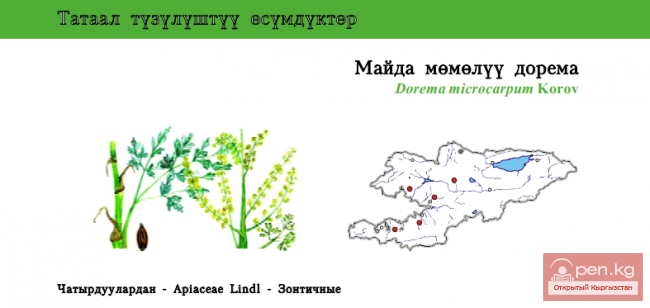
html Korshinsky’s Meadow Saxifrage Status: EN. A rare endemic species found in small numbers and...

Cnidiocarpa alaica Status: VU. A rare representative of a monotypic genus....

Wolly-fruited Kosopoljanskia Status: EN. Endemic. One of the two species that are sub-endemic to...

Aulie-Ata Stemmacantha Centaury Status: EN. A very rare species, critically endangered....

Dorema microcarpum Status: VU. Rare endemic species....

Edelweiss-like Pyrethrum Status: VU. Endemic species....

html Lamyropappus schakaptaricus Status: VU. A rare representative of a monotypic genus....

Seaholly-like Meadow Saxifrage Status: VU. Endemic. One of 16 species found in Kyrgyzstan....

Alai Centaury Status: VU. Endemic species....

Alai Bubblewort Status: VU. A rare narrowly endemic species....

Kaufmannia Semenova Status: VU. Endemic, rare species....

Sclerotiaria pentaceros Status: CR B2ab(iii). Endemic to a monotypic genus....

Schennikov’s Otostegia Status: VU. A rare endemic species, endemic to Kyrgyzstan with a disjunct...

Kostychev’s Pascueflower Status: VU. A narrowly endemic and very beautiful plant, deserving...

Catmint-like Scullcup Status: VU. A very rare narrowly endemic species. Ornamental plant....

False Hooked Fumitory Status: VU. Endemic species of the Pamir-Alai....

Kosopoljanskaya Turkestanian Status: VU. One of the two endemic species of this genus found in...

Iskandera Alai Status: VU. A very rare narrow endemic species. There is only one species of this...

Rosetted Thorough-wax Status: VU. Rare species. One of six species of the genus found in...

Lepidolopha Komarovii Status: EN. An endemic species of mountainous Central Asia, representative...

Kashgarian Barberry Status: VU. Rare species....

Quadrifolious Tulip Status: VU. Endemic to the Inner Tien Shan....

Acantholimon compactum Status: VU. A very rare narrowly endemic species....

Rhodiola litwinowii Status: LC. A mosaic-distributed species, intensively used in agriculture....

Related Tulip Status: VU. Endemic species of the northern Pamir-Alai. The species is at risk of...

Wrapped Alpine Saw-wort Status: VU. Rare species. Found in Kyrgyzstan at the edge of its range....

Orchid-like Juno Status: VU. Endemic to the Western and Northern Tien Shan....

Andrachne-like Scullcup Status: VU. A very rare rocky species, narrowly endemic to a small section...

Hairy Flowering Plant Aulie-Ata Status: EN. A representative of a monotypic section, a narrowly...

Short-winged Bladder-senna Status: VU. One of three very rarely occurring species of this genus in...

Intermediate Hyalolaena Status: VU. Endemic. One of three species growing in Kyrgyzstan....

Olga’s Sorbaria Status: CR B2ab(iii). A rare narrow-endemic species of the Alai Mountain Range....

Semenov’s Onion Status: VU. Endemic to the Inner Tien Shan....

Eugenia’s Bell-flower Status: VU. Endemic to the Western Tien Shan (Talas and Fergana Ranges). A...

Nathaliella alaica Status: CR B2ab(iii). A rare, endemic species of a monotypic genus of Himalayan...

Eremurus zoae Status: VU. A narrowly endemic species of the Kyrgyz Range....

Kashgarian Bean Caper Status: VU. Rare, little-studied endemic species....

Bergenia (Bergenia Moench). The plant retains its foliage year-round. It prefers semi-shaded or...

Regel’s Eminium Status: VU. A rare endemic species of the Western Tien Shan....

Vvedensky’s Sage Status: VU. A very rare narrowly endemic species. An ornamental plant....

Broad-stamened Tulip Status: VU. A narrow endemic of the Alai Ridge....

Golden Trichanthemis Centaury Status: VU. A rare narrowly endemic species of the Alai Ridge, an...

Land resources refer to lands that are systematically used or suitable for use for economic...